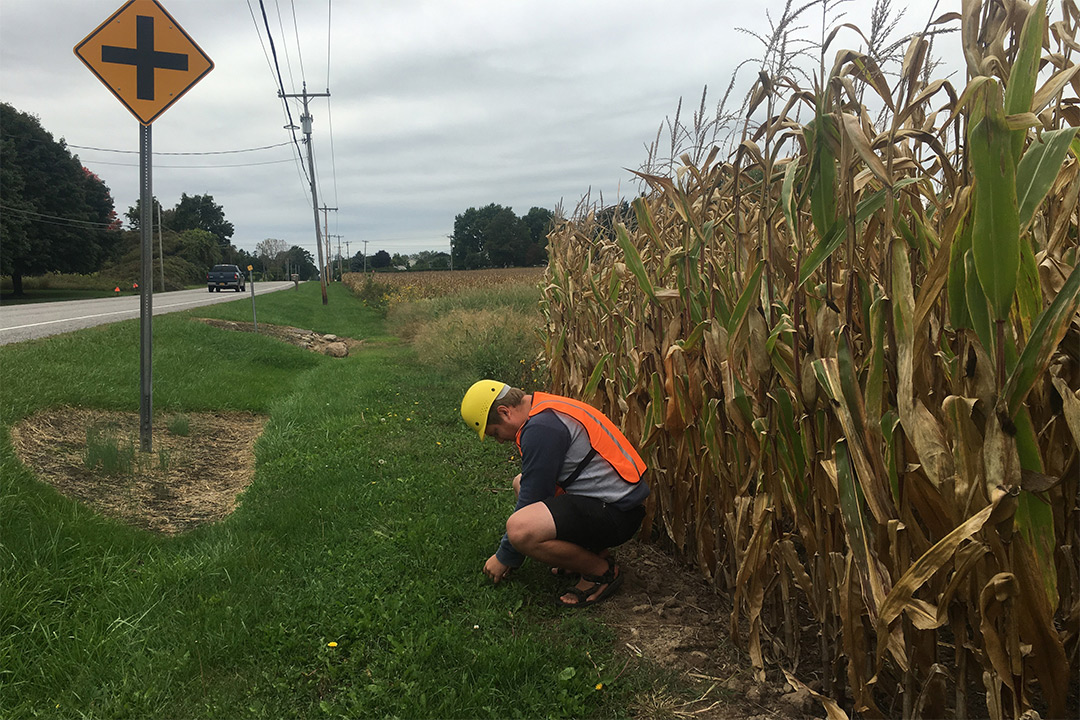RIT researchers contribute to massive Global Urban Evolution Project
Fourth-year environmental science student Aaron Paratore helped collect 650 samples of white clover in the Rochester area in October as part of the Global Urban Evolution Project.
Rochester Institute of Technology environmental science students turned some heads when they stopped to pick white clover plants near a gas station along New York State Route 33A in October. But little did onlookers know that they were helping to conduct the largest evolution study outside of human genomics.
The students were collecting samples for the Global Urban Evolution Project, a massive study spanning six continents that examines how the ubiquitous white clover plants are evolving differently in urban, suburban and rural ecosystems. While many homeowners view the plant as a weed, scientists say it is an important source of nectar for pollinator insects that we can learn a great deal from.
“Because of urban development, plants or animals evolve differently to adapt to the environments that we have created,” said Briana Burt, a fourth-year environmental science student from Madbury, N.H., who is working with four other RIT students on the project for a senior capstone project. “We are interested in studying white clover because it’s a pollinator-friendly species that exists on every inhabited continent in the world. Understanding how development is impacting this one species can help us understand if other species are impacted, how they can be impacted and what’s causing them to be impacted.”
The RIT students collected 650 samples of the plant in 41 urban, suburban and rural locations in October, starting at the center of downtown Rochester and heading southwest along New York State Route 33A to Riga. They then tested the clover samples for a chemical defense called cyanogenesis, which defends against herbivores but causes the plants to be less tolerant to freezing temperatures.
The RIT researchers hypothesized that the urban area will have less cyanogenic clovers compared to the rural sites. They expected rural ecosystems to have more cyanogenic clovers because there are more herbivores and warmer ground temperatures since the snow acts as a blanket to trap heat underground.
When the study’s organizers in University of Toronto Mississauga put out a call looking for collaborators in 200 cities on six continents where the plant grows, RIT Visiting Assistant Professor Kaitlin Stack Whitney volunteered RIT to collect samples for Rochester. She said giving students the chance to participate in distributive collaborative science with hundreds of people across the world provided an important learning experience.
“It’s a great example of how science is so collaborative,” said Stack Whitney. “They’re seeing how much more we can learn by being part of this multi-city experiment. They’re getting trained on the cutting-edge methods of how big teams who want to answer big questions about our environment do this work together.”
In addition to Stack Whitney and Burt, other RIT researchers to contribute to the study included Kristina Chomiak, a fourth-year environmental science student from Rochester; Ibrahim Cisse, a fourth-year environmental science student from Bronx, N.Y.; Benjamin Hamilton, an environmental science graduate student from Addison, N.Y.; and Aaron Paratore, a fourth-year environmental science student from Webster, N.Y.






